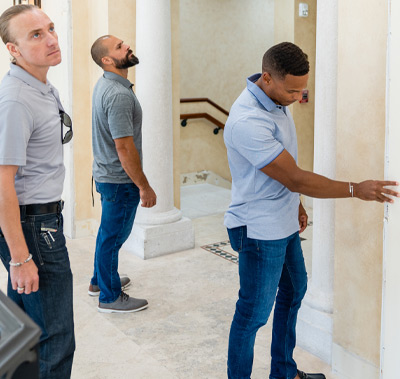Florida Building Safety & Recertification Inspection Services
Comprehensive Building Safety and Recertification Inspections for Peace of Mind
Quick Links:
- What are Building Safety & Recertification inspections?
- The importance Building Safety & Recertification inspections
- How our Safety & Recertification process works
- What we assess during your Building Recerficiation inspection
- Why choose Building Mavens?
- Schedule your Building Recertification inspection
- Frequently asked questions
- Client testimonials
Keeping your property safe, compliant, and up to code is essential – especially in Florida, where unique environmental challenges and recent disasters have created a demand for extra vigilance. At Building Mavens, our Building Safety and Recertification Inspection Services meet that challenge by providing you with a thorough evaluation of your property’s structural and electrical systems to meet local ordinances and protect its long-term integrity. Whether you’re a property owner, condo association board, or building manager, we deliver clear, actionable insights to ensure your building remains safe, functional, and ready for its next chapter.

What are Building Safety & Recertification Inspections?
Upon notification that your building(s) require recertification, building owners are required by law to submit a detailed engineering/inspection report that includes both structural and electrical assessments. As such, our recertification services verify that your property’s structural and electrical systems meet or exceed all current code requirements. Whether you oversee a condominium, commercial property, or residential complex, our state-licensed engineers conduct thorough examinations that align with local building ordinances.
Qualifying buildings within city limits are now subject to a 25-year or 30-year recertification, followed by subsequent inspections every 10 years after that.
Special note: single-family homes and duplexes are exempt from these requirements.
The Importance of Building Safety & Recertification Inspections
Once a non-exempt building reaches certain age milestones – typically 25 or 30 years – local authorities will request recertification to confirm that the structure remains stable and code-compliant. Depending on the findings of the recertification inspection, owners may need to correct their reports, submit a Repair Plan detailing how deficiencies will be addressed, or, if compliant, proceed to full recertification. Following initial recertification, buildings must be recertified every 10 years.
Without meeting requirements set forth by your local city, property owners risk penalties, legal challenges, insurance difficulties, or even building closures. Regular inspections support safety, preserve property value, while preventing expensive surprises and disasters down the road.
How Our Safety & Recertification Process Works
At Building Mavens, we apply a proven, step-by-step strategy to execute and complete your Safety & Recertification Inspection:
- Initial Analysis: We begin by reviewing existing documentation, original plans, and any past inspection records.
- On-Site Evaluation: Our licensed engineers conduct a detailed, hands-on review of key structural and electrical systems as required by your local city/county, identifying areas of concern or future upkeep.
- Reporting: We present our findings in a straightforward report, making it easy for property owners, boards, and investors to understand next steps and make informed decisions.
What We Assess During Your Building Recertification Inspection
Structural Inspections
Our inspection process carefully evaluates the overall condition of your building’s structural components, focusing on how they perform under weight, wind forces, and environmental stressors. While we don’t revalidate the original design, we examine how time and exposure have affected the materials, particularly in Florida’s challenging climate.
Key considerations include:
- Structural Movement: Identifying shifts or settling in critical components that may impact stability.
- Material Deterioration: Assessing wear caused by moisture, salt exposure, and other environmental factors, especially near exterior walls.
Critical structural elements we inspect:
- Foundations: Checking for settling or instability, particularly in older buildings with spread footings.
- Roofs: Evaluating sloped and flat roofs for signs of wear, such as blistering, wrinkling, or damage to membrane systems.
- Masonry Walls: Identifying cracks, bulging, or misalignment in masonry walls, with attention to tie columns and beams.
- Floor and Roof Systems: Examining reinforced concrete slabs, pre-cast components, steel bar joists, and wood framing for signs of weakening.
- Steel and Concrete Framing: Assessing corrosion in steel and rebar damage in permeable concrete.
- Windows and Doors: Inspecting for leakage, damage, and proper anchorage to withstand severe weather.
We also perform detailed inspections of curtain wall glazing, including silicone sealants, for buildings with structural glazing systems, to ensure durability and safety. The entire facade, encompassing walls, cladding, and other elements, is thoroughly examined for potential hazards.
Electrical Inspections
Alongside structural evaluations, we perform comprehensive electrical inspections to ensure compliance and safety in both habitable and non-habitable spaces.
Key electrical components we inspect:
- Electric Service: Evaluating service type, amperage, and grounding, ensuring clearance and proper condition in meter rooms.
- Branch Circuits: Verifying conductor conditions, grounding, and equipment support for all circuits.
- Conduit Raceways: Checking for erosion, dents, or other damage that may compromise wiring safety.
- Emergency Lighting: Inspecting exit signs, emergency lighting, and fire alarm systems to confirm functionality.
- Infrared Thermography: Using certified thermographers to analyze key electrical systems operating at 400 amperes or more for early detection of potential issues.
With a clear focus on both structural integrity and electrical safety, our inspection process fully meets state and local guidelines and provides actionable insights to address issues promptly and maintain a compliant, secure property.
Why OUR CLIENTS CHOOSE US
Schedule Your Building Recertification Inspection
Ensuring your building’s safety and integrity is not just a regulatory requirement but a critical investment in its longevity and value. Don’t wait for small issues to grow into major setbacks. We’re ready to help you maintain a safe, compliant environment that protects your investment and the people who rely on it. Speak with our team today and schedule your Building Safety & Recertification Inspection. Learn more about how we can assist you in meeting the latest building recertification requirements and maintaining the highest standards of safety and compliance in your area.
Frequently Asked Questions
A threshold building, as defined by the Florida Statutes (https://www.flsenate.gov/Laws/Statutes/2022/0553.71) means any building which is greater than three stories or 50 feet in height, or which has an assembly occupancy classification as defined in the Florida Building Code which exceeds 5,000 square feet in area and an occupant content of greater than 500 persons.
A special inspector (SI), as defined by the Florida Statutes (https://www.flsenate.gov/Laws/Statutes/2022/0553.71) means a licensed architect or registered engineer who is certified under chapter 471 or chapter 481 to conduct inspections of threshold buildings. Additionally, the Florida Board for Professional Engineers specifies the requirements for Special Inspectors here:https://fbpe.org/licensure/licensure-process/special-inspector/
In Miami-Dade County single-family residences, duplexes, and minor structures (defined as buildings or structures in any occupancy group having an occupant load of 10 or less, as determined by Table 1004.5 (FBC) Minimum Occupant Load of the Florida Building Code and having a gross area of 2,000 sq. ft. or less) are exempt.
In Broward County one and two-family dwellings, U.S. Government and State of Florida buildings, buildings built on Indian Reservations, school buildings under the jurisdiction of the Broward County School Board, fee simple townhouses as defined in the Florida Building Code, and minor structures (as defined above) are exempt.
Here is a link to Broward County’s Building Safety Inspection Program:https://www.broward.org/CodeAppeals/Documents/Broward%20BORA%20Policy%2005-05.pdf
Here is a link to Miami-Dade County’s Building Recertification Program:https://www.miamidade.gov/global/economy/building/recertification.page
Here is a link to Miami-Dade County’s Municipal Code:https://library.municode.com/fl/miami_-_dade_county/codes/code_of_ordinances?nodeId=PTIIICOOR_CH8BUCO_ARTIAD_S8-11EXBU
The structural inspection involves visually examining the building’s general condition, focusing on components supporting dead or live loads, wind loads, and electrical systems. The goal is to evaluate the effects of time on construction materials and identify potential issues such as cracks, distortion, and signs of leakage.
The electrical inspection covers various critical components, including electric service, branch circuits, conduit raceways, emergency lighting, and an infrared thermography inspection for systems operating at 400 amperes or greater.
The program encourages investigating historical documents with the local jurisdiction to enhance the overall inspection. Understanding the building’s structural system, components, and intended design guides inspectors to critical areas. Violations and unpermitted activities are thoroughly examined during recertification inspections.
Repairs identified in the recertification report will likely require permits. Do not proceed with repairs without obtaining proper permits. Some repairs may not require a permit, but most other work will, and proceeding without permits may lead to code violations.
Using approved report forms is vital for a clear understanding of the building’s conditions and successful completion of the recertification process. Reports must be concise, with required photos in color and sufficient resolution to detail the conditions being shown, as audits may occur at the discretion of the Building Official. To ensure this process is managed correctly, rely on the expertise of Building Mavens. Our team has completed this process hundreds of times. Contact us today.
To schedule a building recertification inspection, please contact us via our website or by phone. We’ll discuss your specific needs and arrange for an inspection at a time that suits you best.
Our clients speak.
“I highly recommend Building Mavens. Building Mavens administrative staff and engineers displayed the utmost professionalism throughout the Milestone inspection process. Questions and concerns asked by the Association’s Board of Directors or Management were responded to promptly.”
“Building Mavens has been integral in helping us be on the right track to comply and I know that through the end of our project, they will still be there until we have our final inspection. Their price was reasonable and their service and guidance exceeded expectations. We would use them again should/when further inspections are required.”
“Building Mavens made my project come to life! I have worked with many engineers in the industry, and I must say that the title suits them. They are truly experts in this industry. From the start of my project to the finish, they were there with us every step of the way. I cannot thank them enough and will use them for future projects!”
“Scott and his team were responsive, friendly, and professional. They quickly identified my issue and guided me through the repair process. I would hire them again and recommend them.”
“Top-notch service. Very knowledgable. Definitely recommend!”
“Working with Scott was great. He was extremely responsive and put things in terms I could understand.”
“What an incredible experience I had with Scott and his team! They were extremely professional, provided quality and detailed service, and were a pleasure to work with! I would highly recommend their service.”
“Building Mavens is genuinely an excellent firm! They respond quickly and professionally, and they are indeed experts in the engineering field.”
“Scott gave me more of his time than he had to when helping me. I was grateful to him for putting his expertise to work for me the way he did. That’s rare.”




